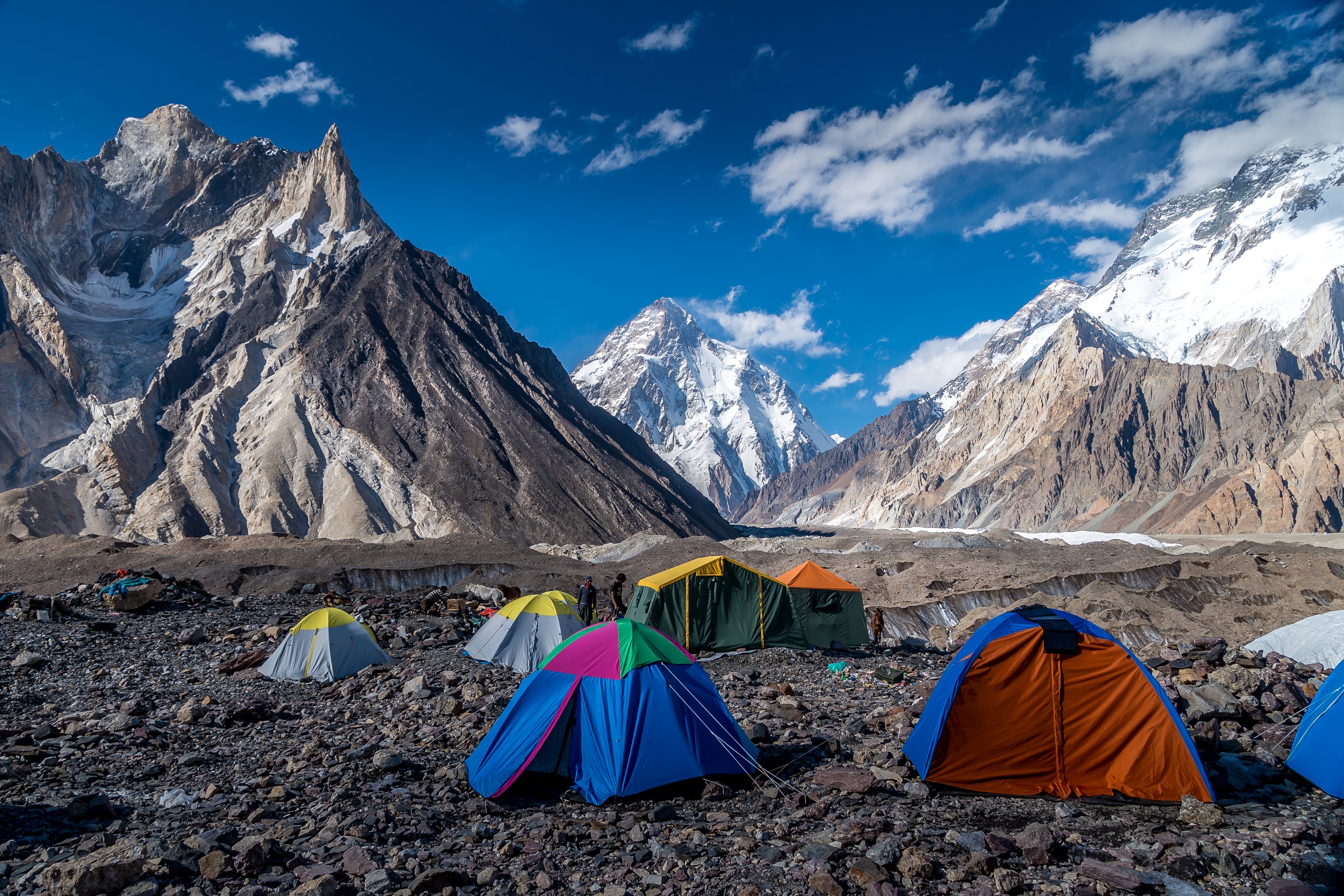FOR CLIMBERS, the existential angst kicks in the moment they round the bend into
Concordia, the most majestic amphitheater of high peaks in the world. An enormous
hub of ice situated six miles from base camp, where the Upper Baltoro and GodwinAusten glaciers collide, Concordia is surrounded by the crown of the Karakoram—
Broad Peak and Gasherbrum I, II, and III—four of the 15 tallest mountains on earth, with an average height of 26,330 feet. To the east, the fluted ridges of Ladakh rise above the Siachen Glacier, the front lines of an ongoing border conflict between India and Pakistan. And if the weather is clear, a mountaineer will get his first glimpse of K2 directly to the north, filling up the sky, lustrous and giant.
"You're standing at 15,000 feet, and you're looking up at 28,000 feet," says Jim
Wickwire, a 63-year-old climber from Seattle and a member of the first American team
to summit K2, in 1978. "No photograph can do justice to 13,000 feet of vertical relief."
Nor can a photograph convey the ponderous immensity of a pile of rock and ice large
enough to contain no fewer than 84 Matterhorns. "When I reached Concordia and saw K2, it literally stopped me in my tracks," recalls Rick Ridgeway, 54, who made it to the summit alongside Wickwire in '78. "It stopped us all—that mountain affects
everybody in the same way. Nothing on the whole planet matches it."
Even Reinhold Messner, who at 59 is generally considered the greatest mountaineer of the 20th century, reserves a special measure of awe for K2, which he christened "the mountain of mountains" in 1979, after completing the fourth ascent of the peak. "It is the most beautiful of all the high peaks," Messner told me. "An artist has made this
mountain."
There are a handful of fiendishly arduous Himalayan peaks that pose even greater
technical challenges than K2, the most prominent being Gasherbrum IV (26,000 feet)
and the Ogre (23,900 feet), both located in the central Karakoram. Neither of these,
however, involves the difficulties posed by the extreme altitude of K2, where even the
most popular passage up—the Abruzzi Ridge—leaves no room for error. A steep
spur on the southeastern side first explored in 1909 by Italy's Prince Luigi Amedeo of
Savoy, Duke of Abruzzi, it involves more than 11,000 vertical feet of climbing and is
approximately 20 degrees steeper than the South Col, the most heavily trafficked path
up Everest.
Abruzzi made it to 20,500 feet—above where Camp 1 sits today—before abandoning
his attempt. If anyone ever reaches the summit, he later declared, "it will be a pilot, not a mountaineer." But on July 31, 1954, two Italian climbers, Lino Lacedelli and Achille Compagnoni, topped out using Abruzzi's route. Compagnoni later claimed he
heard the voice of an angel beckoning him to the summit; when he reached it, on his
knees, he felt something on his face. "There was ice under my eyes," he later said in an
interview. "I realized I was crying. Frozen tears."
He had good reason. Of the 196 climbers who have summited K2 since 1954, 144
arrived by way of the Abruzzi Ridge. And of the 53 people lost on the mountain since
1938, 36 perished somewhere along its spine.
The ridge begins with a line of towers that stretch up the lower part of the spur, ending
in a 100-foot vertical fissure known as House's Chimney, named after Bill House, an
American mountaineer who first climbed it in 1938. The pitch involves 5.6 rock
climbing at 22,000 feet—the route's greatest technical challenge.
Above the chimney lies the Black Pyramid, a triangle of notoriously unstable slabs of
ice and rock at about 24,500 feet. At the pyramid's apex, the route emerges onto the
Shoulder, a broad hump at roughly 26,000 feet and the site of the fourth and final
camp before reaching the top. It was here in 1986 that Al Rouse, the first British
climber to summit K2, was overcome by exhaustion and abandoned by his
companions in the middle of a six-day storm. Minutes after leaving Rouse, two
Austrian climbers, Alfred Imitzer and Hannes Wieser, collapsed in the snow and died
as well.
From the Shoulder, the summit is 2,250 vertical feet away. But reaching it involves
negotiating a broad couloir often loaded with knee-deep snow; undertaking a delicate
traverse out of the Bottleneck, a 100-foot ice-enameled couloir that steepens to more
than 50 degrees; and then scaling an exposed traverse that drops 9,800 feet to the
Godwin-Austen. At least ten people have died in the Bottleneck—including the Polish
climber Tadeusz Piotrowski, perhaps the finest winter mountaineer of his day, who in
1986 lost both his crampons in the midst of a grueling descent from the summit,
bounced off his partner, Jerzy Kukuczka (who managed to keep his footing), and
hurtled off the face.
Finally, there are the snowy slopes of the summit helmet itself, which are broad and
steep and, as anyone familiar with the gut-wrenching plummet of Alison Hargreaves
and her companions in 1995 can attest, more than able to kill you.


